Best Duvet for Toddler Beds
Cooler nights call for additional layers, and when it comes to your children, you want to ensure they get a good night’s rest, uninterrupted by fluctuations in temperature. Once your child reaches the toddler stage around one year of age, they are considered strong and in control enough to have blankets and pillows placed in their beds.
A duvet is a perfect choice for your toddler’s bed. Not only are they available in varying weights, but also come in material choices and decorative styles to match your nursery decor. The best duvet for toddler beds is those that are easy to launder and are of durable quality. Below we explain why they are an excellent choice compared to other types of bedding and why they are well worth considering.
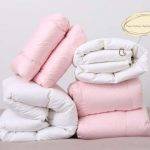
1. Toddler White Goose Down Comforter Duvet – Editor's Choice
- Fill: Goose Down
- Weight: light and medium weight
- Cover: 100%, 500 thread count cotton
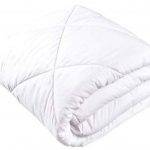
2. MEJU 100% Polyester Midweight Duvet
- Fill: Polyester Fiber
- Weight: Light and medium weight
- Cover: 100% microfiber polyester
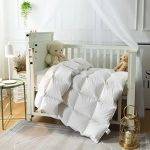
3. ROSE FEATHER Goose Down Duvet
- Fill: Goose down
- Weight: lightweight
- Cover: 100%, 800 thread count cotton
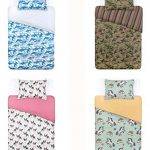
4. Tadpoles Toddler Comforter Duvet
- Fill: down alternative poly fiber
- Weight: lightweight
- Cover: 100% microfiber
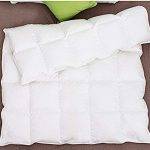
5. C&L Baby Summer Lightweight Crib Duvet
- Fill: White Goose Down
- Weight: Lightweight
- Cover: 100%, 800 thread count cotton
Table Of Contents
- Best Duvet for Toddler Beds
- 1. Toddler White Goose Down Comforter Duvet
- 2. MEJU 100% Polyester Midweight Duvet
- 3. ROSE FEATHER Goose Down Duvet
- 4. Tadpoles Toddler Comforter Duvet
- 5. C&L Baby Summer Lightweight Crib Duvet
- <b>Child Development</b>
- <b>What is a Duvet?</b><span style=”font-weight: 400;”></span>
- <b>Duvets vs Other Blankets</b>
- <b>Best Material Choices for Toddlers</b>
- — <b>Fill Power</b>
- — <b>Tog Rating</b>
- — <b>Cover Materials</b>
- — <b>Style</b>
- <b>Conclusion</b>
Best Duvet for Toddler Beds
1. Toddler White Goose Down Comforter Duvet – Editor's Choice
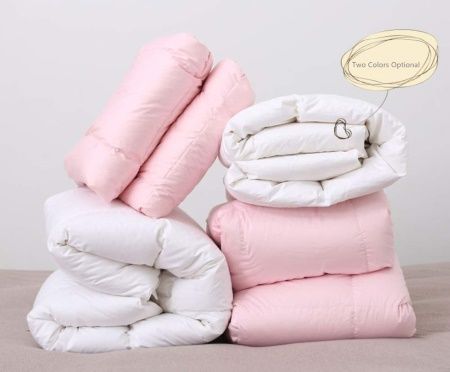
Highlights
- Fill: Goose Down
- Weight: light and medium weight
- Cover: 100%, 500 thread count cotton
Pros
- Fill: Goose Down
- Weight: light and medium weight
- Cover: 100%, 500 thread count cotton
This lightweight white goose down filled toddler duvet is designed to fit all baby and toddler sized beds. The 100%, 500 thread count cotton cover ensures excellent breathability and ensures your down stays where it belongs- inside the Bavarian box style quilting. The duvet insert comes in two colors: white and pink, and two sizes which indicate their fill power so you can choose between light and medium weight coverage for all-season to cool night protection.
2. MEJU 100% Polyester Midweight Duvet
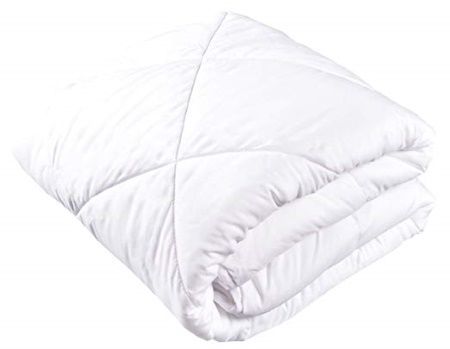
Highlights
- Fill: Polyester Fiber
- Weight: Light and medium weight
- Cover: 100% microfiber polyester
Pros
- Fill: Polyester Fiber
- Weight: Light and medium weight
- Cover: 100% microfiber polyester
Designed for the cooler nights of spring and fall, the Meju midweight duvet is filled with a soft microfiber polyester that mimics the feel of a soft down. Also available in lightweight version, this is the perfect little insert for a toddlers bed. The soft cover is a poly microfiber as well to provide a soft surface for delicate skin. Easy to wash, the whole thing can be tossed in the washing machine and dryer when needed. It is quilted in a diamond pattern to help keep the fill evenly covered, and the company also offers matching duvet cover sets and pillowcases.
3. ROSE FEATHER Goose Down Duvet
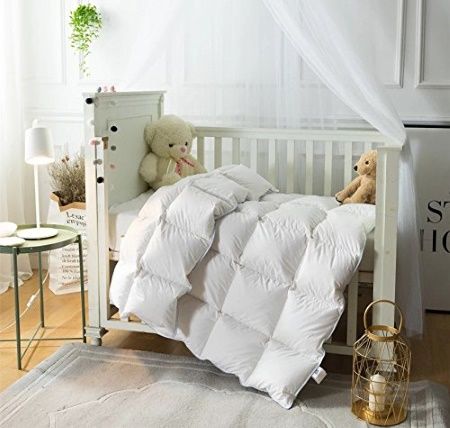
Highlights
- Fill: Goose down
- Weight: lightweight
- Cover: 100%, 800 thread count cotton
Pros
- Fill: Goose down
- Weight: lightweight
- Cover: 100%, 800 thread count cotton
The Rose Feather Goose Down Duvet is available in three sizes for various sized beds and comes in two colors: purple and white. Box stitching keeps the quality down where it belongs and the 800 thread count, 100% cotton cover is both thick and durable and well as soft and comforting. Easy to wash, simply toss in the washing machine and let air dry and tumble of fluff if desired. This is a lightweight choice for all season warmth and layers well if needed.
4. Tadpoles Toddler Comforter Duvet
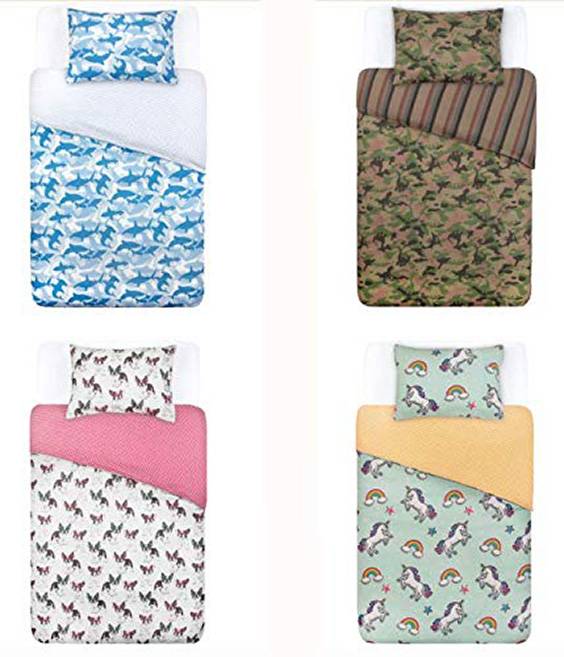
Highlights
- Fill: down alternative poly fiber
- Weight: lightweight
- Cover: 100% microfiber
Pros
- Fill: down alternative poly fiber
- Weight: lightweight
- Cover: 100% microfiber
The Tadpoles Toddler Duvet comes in 3 different colors, gray, pink, and white, and is also offered in 3 different patterns: box, unicorn, and teddy bear stitched to provide an even spread of filling. Filled with a down alternative polyester, it is considered an all-season, lightweight choice. The cover is a soft polyester microfiber shell as well – making it easy to throw in the washing machine and dryer.
5. C&L Baby Summer Lightweight Crib Duvet
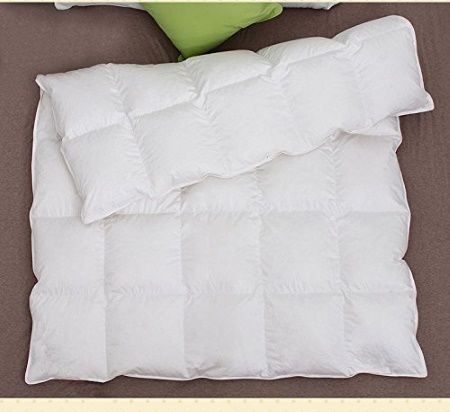
Highlights
- Fill: White Goose Down
- Weight: Lightweight
- Cover: 100%, 800 thread count cotton
Pros
- Fill: White Goose Down
- Weight: Lightweight
- Cover: 100%, 800 thread count cotton
With two sizes and colors available, this lightweight duvet by C&L is a quality white goose down filled option. The box baffle is double stitched and the 800 thread count cotton is both durable and soft for proper fill coverage. Easy to wash by hand or on a gentle cycle, you can also tumble dry on low at any time after washing or to fluff.
You may be interested in: Best Toddler Mattresses
Child Development
Children under 12 months are considered too young to have blankets or pillows in their crib with them. Any loose materials (blankets, pillows, stuffed animals, etc…) can create hazards under which a baby’s airways may become covered- and those under a year are considered not strong enough to move these materials or get out from under them without help. They also can create situations in which the child overheats.
But once a child is a year or older, you can begin adding blankets and pillows to a child’s bed and release that decorative energy you have been waiting for. Rather than piling on more than one blanket for warmth, it is best to choose one that is both insulating and lightweight. This keeps your child from being tangled up in multiple layers, and provide insulation for both warm and cool nights for year round comfort.
You may want to read: Best Toddler Bed Frame
What is a Duvet?
In short, a duvet is a lightweight quilt that is filled with down, feathers, or similar soft synthetic (or blend of these) to provide an insulating cover. They are used in place of a sheet and blanket combination to provide. Plain in nature, the duvet is generally has a cotton casing that is encased within a duvet cover- allowing you to quickly and easily launder the cover, and change it up to fit your decor variances.
You may want to read: Duvet vs Quilt: How to Choose
Duvets vs Other Blankets
As mentioned, other blankets or comforters are generally made to be used with a top sheet. Although a duvet is made to work on its own, it can be layered with a blanket as well, but it serves as a sheet and blanket all in one. Comforters and blankets are stylized all their own and bought to match your decor. A duvet cover can be easily, and cheaply, traded out- plus you rarely have to wash your entire duvet unlike having to wash a full, heavy blanket. Simply toss the cover in the wash on laundry day. This is incredibly convenient for young children who seem to create dirt wherever they roam (speaking from experience as a mom on two boys)!
You may be interested in: Best Pillows for Toddlers
Best Material Choices for Toddlers
As mentioned, duvets come in a choice of filling, either natural down and feathers or a synthetic polyester that is designed to mimic the softer feel of down (you may also find silk and wool fillings as well). All are excellent choices that provide years of insulating protection, but be aware that synthetic fibers do break down faster than natural, and may eventually clump or compress and not be as soft over time.
— Fill Power
The fill power of a duvet should also be taken into consideration. These numbers are related to how much weight of a filling covers a square inch of space. The larger the number the loftier, and airier the duvet will be. It is these pockets of air created by the higher fill that provide more insulating power. If your home is generally cooler, or you live in a colder climate, then choose your fill accordingly. A lightweight choice generally falls around a 450 fill, with the number rising to 900.
— Tog Rating
You may also see the word ‘tog’ used in relation to child’s duvet choices. The tog of a duvet refers to the overall warmth provided by the cover. The higher the tog, the warmer the duvet. Children generally have a warmer body temperature and so the tog rating is somewhat related to their age range. Tog ratings between 1 and 4 are generally chosen for toddlers, with a 10 rating for children 10 years of age and older are considered acceptable.
— Cover Materials
Almost all duvet covers are made of cotton. This natural, breathable material allows for excellent airflow. Be sure to shoot for a 200 thread count or higher cotton to ensure good structure and to keep from losing any fill especially down and feather which may have small quill ends that work their way through more loosely woven material. Occasionally you may find a polyester or polyester blend, but these may denote a less quality product.
— Style
Most duvets come in a baffle box or Bavarian box style to help keep the filling more evenly dispersed and from shifting into only one area. Bavarian boxes are seen through the entire cover and keep everything very well spaced out. Baffle boxes are seen through as well, but provide ‘walls’ between each box to be used with thicker, more highly filled covers. Both styles also help keep the filling from becoming compressed and provide room to be fluffed back up.
You may want to read: The Best Baby Blankets
The following options are some of the most popular duvets with consumers with young children. Their reviews reflect a high quality of workmanship and material choice and are chosen due to comfort and style. Duvet sets are also popular, but rarely include the actual duvet itself and only a matching cover and pillowcases. Sets are popular if you already have the duvet insert to match colors, characters (such as Mickey and Minnie Mouse), or decor as your child grows.
Conclusion
When it’s time to begin providing bedding for your young children, it’s smart to add a simple layer for warmth and comfort rather than piling on multiple options which can tangle them up or create overheating. Duvets come in various weights for easy insulating warmth through the seasons and are lightweight and easy to kick off with little toddler legs if discomfort ever occurs.
The options provided above allow you to see the range of quality and cost offered, as well as the size and use for your child’s needs. All come highly recommended for their uses and are well made with various materials and top-notch workmanship.
